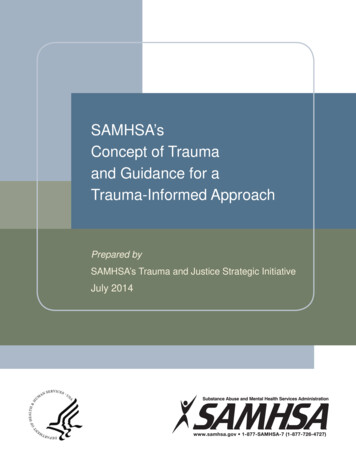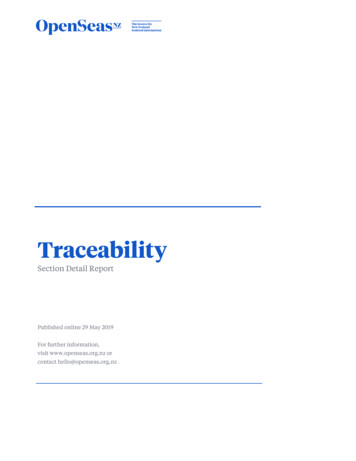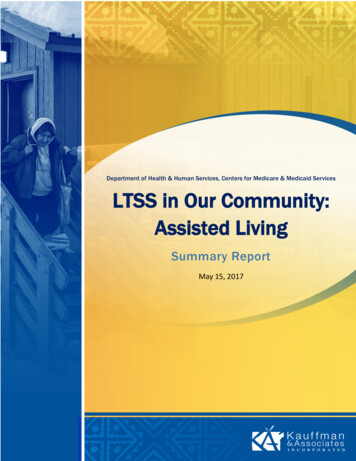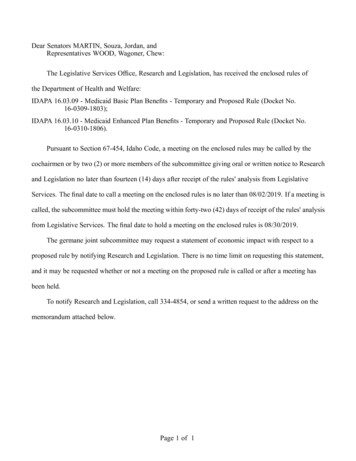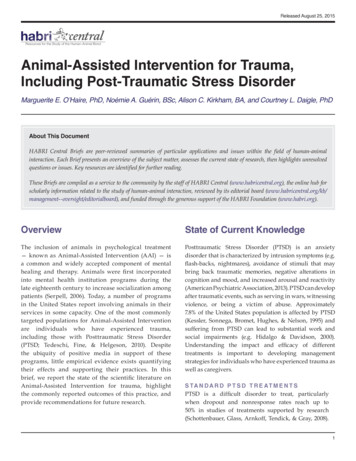
Transcription
Released August 25, 2015Animal-Assisted Intervention for Trauma,Including Post-Traumatic Stress DisorderMarguerite E. O’Haire, PhD, Noémie A. Guérin, BSc, Alison C. Kirkham, BA, and Courtney L. Daigle, PhDAbout This DocumentHABRI Central Briefs are peer-reviewed summaries of particular applications and issues within the field of human-animalinteraction. Each Brief presents an overview of the subject matter, assesses the current state of research, then highlights unresolvedquestions or issues. Key resources are identified for further reading.These Briefs are compiled as a service to the community by the staff of HABRI Central (www.habricentral.org), the online hub forscholarly information related to the study of human-animal interaction, reviewed by its editorial board torialboard), and funded through the generous support of the HABRI Foundation (www.habri.org).OverviewState of Current KnowledgeThe inclusion of animals in psychological treatment— known as Animal-Assisted Intervention (AAI) — isa common and widely accepted component of mentalhealing and therapy. Animals were first incorporatedinto mental health institution programs during thelate eighteenth century to increase socialization amongpatients (Serpell, 2006). Today, a number of programsin the United States report involving animals in theirservices in some capacity. One of the most commonlytargeted populations for Animal-Assisted Interventionare individuals who have experienced trauma,including those with Posttraumatic Stress Disorder(PTSD; Tedeschi, Fine, & Helgeson, 2010). Despitethe ubiquity of positive media in support of theseprograms, little empirical evidence exists quantifyingtheir effects and supporting their practices. In thisbrief, we report the state of the scientific literature onAnimal-Assisted Intervention for trauma, highlightthe commonly reported outcomes of this practice, andprovide recommendations for future research.Posttraumatic Stress Disorder (PTSD) is an anxietydisorder that is characterized by intrusion symptoms (e.g.flash-backs, nightmares), avoidance of stimuli that maybring back traumatic memories, negative alterations incognition and mood, and increased arousal and reactivity(American Psychiatric Association, 2013). PTSD can developafter traumatic events, such as serving in wars, witnessingviolence, or being a victim of abuse. Approximately7.8% of the United States population is affected by PTSD(Kessler, Sonnega, Bromet, Hughes, & Nelson, 1995) andsuffering from PTSD can lead to substantial work andsocial impairments (e.g. Hidalgo & Davidson, 2000).Understanding the impact and efficacy of differenttreatments is important to developing managementstrategies for individuals who have experienced trauma aswell as caregivers.S TA N D A R D P T S D T R E AT M E N T SPTSD is a difficult disorder to treat, particularlywhen dropout and nonresponse rates reach up to50% in studies of treatments supported by research(Schottenbauer, Glass, Arnkoff, Tendick, & Gray, 2008).1
The most common and effective psychological therapiesinclude Cognitive Behavioral Therapy and Eye MovementDesensitization and Reprocessing (for a systematic review,see Bisson, Roberts, Andrew, Cooper, & Lewis, 2013). Boththese treatments are based on managing the resurgenceof traumatic memories. One type of Cognitive BehavioralTherapy, called Exposure Therapy, is not commonlyundertaken by therapists because of the perceived levelof difficulty and discomfort to patients (e.g. Becker,Zayfert, & Anderson, 2004). Therefore, discovering andevaluating alternative and complementary therapies hasbeen deemed imperative (Bomyea & Lang, 2012; Cukor,Spitalnick, Difede, Rizzo, & Rothbaum, 2009), and this iswhere Animal-Assisted Intervention may be a successfulalternative.ANIMAL-ASSISTED INTERVENTION (A AI)The term Animal-Assisted Intervention is broadly definedas “any intervention that includes an animal as part ofthe process” (Kruger & Serpell, 2010). Animal-AssistedIntervention serves as an umbrella term that encompassestargeted therapeutic interventions with animals (AnimalAssisted Therapy), less structured enrichment activitieswith animals (Animal-Assisted Activities), and theprovision of trained animals to assist with daily lifeactivities (Service or Assistance Animals).A recent review of the literature on nsistentterminology across research efforts (O’Haire, Guérin,& Kirkham, Under review). Seven different terms wereused to describe Animal-Assisted Intervention across tenstudies. The most common term was Animal-AssistedTherapy, but up to six other different terms were used (i.e.Canine-Assisted Therapy, Dog-Assisted Therapy, EquineFacilitated Therapy, Equine-Facilitated Psychotherapy,Natural Horsemanship, and Psychiatric Service Dog).These types of terminology inconsistencies can createconfusion among service providers and the generalpublic as they navigate services for individuals who haveexperienced trauma. Therefore emphasizing the use ofconsistent terminology by researchers and practitionersis paramount to the long-term efficacy of these programs.Anecdotal and qualitative reports have indicated thatthere are numerous potential benefits of Animal-Assisted Intervention for individuals who have experiencedtrauma. Examples include increased feelings of comfort(Yount, Ritchie, St. Laurent, Chumley, & Olmert, 2013), andreduced feelings of loneliness (e.g. Banks & Banks, 2002)and hyperarousal (e.g. Barker, Pandurangi, & Best, 2003).Interacting with animals has also been shown to facilitatesocial interactions (e.g. McNicholas & Collis, 2000; Wood,Giles-Corti, & Bulsara, 2005), provide opportunities formindful experiences in the present (Parish-Plass, 2008),and stimulate overall positive emotions (e.g. Marr et al.,2000; O’Haire, McKenzie, Beck, & Slaughter, 2013).Beyond anecdotal literature, several factors suggest thatAnimal-Assisted Intervention may be an effective complementary treatment for trauma. Interacting with an animalhas been linked to reductions in indicators of stress inhumans, including lower salivary cortisol and blood pressure (Friedmann & Son, 2009), demonstrating that physicalinteraction with another species can impact human physiological stress responses. This body of evidence suggeststhat Animal-Assisted Intervention may be a successfulcomplementary approach in addressing the psychologicalchallenges associated with PTSD.Figure 1. Studies about Animal-Assisted Intervention for traumasince 2004. Grey: unpublished theses, black: published journalarticles.Yet despite the theoretical promise of Animal-AssistedIntervention to mitigate the symptoms associated withtrauma, and its popularization through anecdotal media(Taylor, Edwards, & Pooley, 2013), the latest review of theresearch described a non-unified and nascent field of research, with sparse empirical evidence to support its effectiveness (O’Haire et al., Under review) (Figure 1).HABRI Central Briefs: Animal-Assisted Intervention for Trauma, Including Post-Traumatic Stress Disorder2
as facilitators of the interaction between the therapistand the client, in individual (Murrow, 2013) and grouptherapy (Dietz, Davis, & Pennings, 2012). Activities withdogs included petting or going on a walk with the dogto reduce arousal, talking to the dog about the traumaticevents that occurred in the patient’s past, or listening to atherapeutic story about the dog.OUTCOMESFigure 2. Animal species most commonly participating in researchon Animal-Assisted Intervention for trauma.Clearly defining the state of the scientific literature onAnimal-Assisted Intervention for trauma is imperativeto furthering this arena of research and practice. Inthe following sections, we will review the researchon activities and outcomes from Animal-AssistedIntervention, categorized by the most commonly includedspecies (Figure 2).AAI WITH DOGSDogs are the most commonly included species inAnimal-Assisted Intervention for trauma. AnimalAssisted Intervention with dogs has been identifiedin the literature as Canine-Assisted Therapy orDog-Assisted Therapy. During Animal-AssistedIntervention, dogs are usually accompanied by theirhandler. Service dogs are defined by the Americanswith Disabilities Act as dogs individually trained todo work or perform tasks for people with disabilities,so for a person with PTSD, they could help calm theirhandler during an anxiety attack. A growing numberof organizations provide dogs as service or assistanceanimals to people suffering from PTSD.ACTIVITIESResearch on Animal-Assisted Intervention with dogshas primarily focused on Service Animals for warveterans and Animal-Assisted Therapy for childrenand adolescents who have witnessed violence orwere physically or sexually abused. Dogs have beenincluded in Animal-Assisted Therapy for trauma asthe main focus of a recovery program (Hamama et al.,2011), or incorporated in a traditional clinical settingOutcomes of Animal-Assisted Intervention with dogsfor trauma have been reported with respect to PTSDsymptoms and common comorbid disorders, as well asother indicators of quality of life. Studies on AnimalAssisted Therapy have reported decreased PTSDsymptoms (Dietz et al., 2012; Hamama et al., 2011), andreduced depression (Dietz et al., 2012; Hamama et al.,2011), anxiety, and dissociation symptoms (Dietz et al.,2012). These results were enhanced when the dog had aclear purpose in the intervention, for example if it wasintegrated in a therapeutic story (Dietz et al., 2012).One study also recorded increased approach behaviorstoward the dog over the course of the program,indicating a growing relationship between the childrenand the dog (Murrow, 2013). Two studies did not reportchanges in specific areas of interest, including socioemotional competencies (Murrow, 2013) and subjectivewell-being (Hamama et al., 2011) following AnimalAssisted Therapy with dogs.Only one study has been conducted on ServiceAnimals for trauma. In a series of interviews, warveterans who had service dogs reported improvedsleep quality, reduced social anxiety, and taking lessmedication after they had received their dog (Newton,2014). The main drawback listed by these participantswas that there were some difficulties associated withpublic access for their dogs, since there may be a lackof public awareness about the purpose and importanceof service animals for veterans and trauma survivors.Dogs have also been reported to have a positive effectsimilar to that of a human partner on perceivedstress during a controlled traumatic situation (LassHennemann, Peyk, Streb, Holz, & Michael, 2014). Thiscould point to Animal-Assisted Intervention withdogs as a means to reduce stress in the aftermath oftraumatic events.HABRI Central Briefs: Animal-Assisted Intervention for Trauma, Including Post-Traumatic Stress Disorder3
AAI WITH HORSESHorses have been included in Animal-Assisted Interventionfor survivors of child abuse and war veterans. The inclusionof horses in Animal-Assisted Intervention for trauma variesin format and terminology. The terms used to designateAnimal-Assisted Intervention with horses in research haveincluded Equine-Facilitated Therapy and Equine-FacilitatedPsychotherapy, as well as words to describe the activities withhorses as Basic Horsemanship and Natural Horsemanship.ACTIVITIESActivities with horses can consist of ground-basedactivities, mounted activities, or a combination of the two.Examples of ground-based activities include the provisionof education about horses, grooming horses, observinghorse behavior, and using body language to direct thehorse around a pen. Mounted activities are less common angenerally include basic riding exercises, such as directingthe horse at a slow pace.OUTCOMESIn research on Animal-Assisted Intervention with horses,the main outcomes include reductions in PTSD symptoms(Kemp, Signal, Botros, Taylor, & Prentice, 2013; McCullough,2011; Nevins, Finch, Hickling, & Barnett, 2013) and indepression (Kemp et al., 2013; Nevins et al., 2013). Studieswith survivors of child abuse also described decreases indissociation symptoms and anxiety (Kemp et al., 2013), as wellas a strengthened human-animal bond (McCullough, 2011).Preliminary results with war veterans identified positive,long-lasting effects of Animal-Assisted Intervention, such asincreased happiness, social support and better sleep quality.These positive benefits were observed to have continuedefficacy up to six months after engaging in a four-dayAnimal-Assisted Intervention program (Nevins et al., 2013).Despite positive changes reported for PTSD, it is importantto note that a recent review paper has challenged theefficacy of Animal-Assisted Intervention with horses morebroadly due to threats to the validity of many study designs(Anestis, Anestis, Zawilinski, Hopkins, & Lilienfeld, 2014).Further studies on this topic should focus on addressing theshortcomings noted in this paper.A A I W I T H FA R M A N I M A L SResearch has also been conducted on Animal-AssistedIntervention with farm animals. In these programs,children with a history of abuse visited a farm wherethey had the opportunity to interact with a variety ofanimal species, such as rabbits, pigs, chickens, and lamasin addition to the more traditional Animal-AssistedIntervention species of dogs and horses (Balluerka, Muela,Amiano, & Caldentey, 2014; Woolley, 2004).ACTIVITIESDue to the diversity of species present on farms, the interactions with the animals were varied and not standardized. For example, children could either choose an animalto interact with preferentially (Balluerka et al., 2014), orthey could switch the animal they were interacting withbetween and during sessions (Woolley, 2004). Activities included petting, training, or talking to the animals.OUTCOMESThe outcomes reported for children who participated inAnimal-Assisted Intervention with farm animals includedshort-term reductions in depression and anxiety (Woolley, 2004), and increased attachment security to relatives(Balluerka et al., 2014). However, no changes were recorded with respect to PTSD symptoms or global functioning(Balluerka et al., 2014; Woolley, 2004).Taken together, there is a promising body of initial research on the effects of Animal-Assisted Intervention fortrauma. However, given the preliminary nature of manyof the studies as well as the varied populations and outcomes, it is essential to follow up with further research.Areas for Future InvestigationPTSD symptoms (Kemp, Signal, Botros, Taylor, & Prentice,2013; McCullough, 2011; Nevins, Finch, Hickling, & Barnett,2013) and in depression (Kemp et al., 2013; Nevins et al.,2013). Studies with survivors of child abuse also describeddecreases in dissociation symptoms and anxiety (Kempet al., 2013), as well as a strengthened human-animalbond (McCullough, 2011). Preliminary results with warveterans identified positive, long-lasting effects of AnimalAssisted Intervention, such as increased happiness, socialsupport and better sleep quality. These positive benefitswere observed to have continued efficacy up to six monthsafter engaging in a four-day Animal-Assisted Interventionprogram (Nevins et al., 2013). Despite positive changesreported for PTSD, it is important to note that a recentreview paper has challenged the efficacy of Animal-HABRI Central Briefs: Animal-Assisted Intervention for Trauma, Including Post-Traumatic Stress Disorder4
Assisted Intervention with horses more broadly due tothreats to the validity of many study designs (Anestis,Anestis, Zawilinski, Hopkins, & Lilienfeld, 2014). Furtherstudies on this topic should focus on addressing theshortcomings noted in this paper.TECHNIQUE REFINEMENTWith respect to the techniques and protocols, there was oftennot enough detail presented to allow for replication (either inresearch or clinical practice). Providing detailed proceduresis essential to enable independent research teams to build acoherent, ongoing body of research that validates the efficacyof the programs. Publishing manuals for widespread use isalso critical to enable practitioners to implement any programsthat are demonstrated to be effective through research.Future investigators should use measurement instrumentsdesigned to increase the replicability of studies and thereliability of their results. Small scale studies will be requiredas a first step in PTSD treatment research to document thefeasibility, safety, and potential benefits of these treatments(Rosenberg, Jankowski, Fortuna, Rosenberg, & Mueser, 2011).There is limited, if any research, which directly addressesthese outcomes. Next, the development of manualized,replicable protocols will be needed to enable evaluation ofgeneralizability in research and consistent implementationin community practice (Cukor et al., 2009).Treatment manuals are a critical component of establishingevidence-based interventions (Foa, Cashman, Jaycox, & Perry,1997), and should be developed along with fidelity checkliststo assess treatment integrity. The efficacy of such standardizedprocedures can subsequently be tested against control conditions in randomized clinical trials. A standard of care controlcondition is essential to establish whether or how Animal-Assisted Intervention can add value to existing approaches. Follow-up studies may then compare Animal-Assisted Intervention to other treatments to disentangle the effects of the animalfrom other factors such as participating in a new treatment,meeting with a friendly interventionist, or other non-animalcomponents of the intervention. The challenge for future Animal-Assisted Intervention research will be to identify suitablecontrols to specifically investigate these factors.RISK OF BIASThe methodology employed for assessing the impactof Animal-Assisted Intervention for trauma can easilysuffer from bias. Many of the research efforts have usedinformant report measures from parents or participants.These are critical to capture individual perceptions relatedto depression, anxiety, and quality of life. However,parents reporting on their children may want to see aneffect, and perceive one when it may or may not be present.Researchers who are invested in their hypotheses may bemore likely to report changes than independent raters.It is important in future studies to combine informantreports with potentially less biased outcome measuressuch as blinded behavioral observation or physiologicalassessment to capture a holistic picture of possibleoutcomes. For example, in addition to asking a participantabout nightmares and sleep quality, telemetric monitoringdevices could be worn at night to track sleep patterns andarousal.Another potential risk of bias occurs when the researchteam is personally involved in the Animal-AssistedIntervention program, such as an animal handler ortreatment facility manager. Such conflicts of interestemphasize the larger problem of researcher expectancybias in Human-Animal Interaction studies (Herzog,2011). In some cases, the credibility of the findings canbe increased if the research team and service providersare independent. In situations where this is not feasibleor would hinder study productivity, it is important todevelop studies with controls in place for potential biases,such as blinding the researchers or program personnelfrom participant conditions or collecting blindedobservational data or physiological assessments. Thefield of Human-Animal Interaction research is filled withunique challenges and nuances that require creative andattentive researchers to build a coherent and reliable bodyof research.T YPE OF TRAUMAThe existing literature primarily reports the outcomes ofAnimal-Assisted Intervention for victims of childhoodtrauma such as abuse or domestic violence. Little researchhas been conducted on the impact of Animal-AssistedIntervention for war trauma. In studies examining theimpact of Animal-Assisted Intervention for trauma, thespecific origin of the participant’s trauma is often notreported, and the grouping of individuals with differentsources of trauma may limit the specificity of the findings.Future studies should carefully report the type of traumathe participants experienced as well as their demographicHABRI Central Briefs: Animal-Assisted Intervention for Trauma, Including Post-Traumatic Stress Disorder5
information to better identify which groups would benefitmost from Animal-Assisted Intervention. It is possible thatsurvivors of different types of trauma may benefit fromdifferent forms of Animal-Assisted Intervention. Furtherresearch is necessary to better understand how differentsubgroups respond so that programs can be tailored formaximal efficacy.A N I M A L W E L FA R EThe critical component of any Animal-AssistedIntervention is the inclusion of the animal. However,little research has been conducted to investigate theimpact of Animal-Assisted Intervention on animalwelfare. We suspect that a high level of animal welfareis necessary to achieve positive outcomes for practical,safety, and ethical reasons. If the animal is in a stressfulsituation, or is uncomfortable while engaged in theAnimal-Assisted Intervention, then the animal may actunexpectedly, fearfully, or aggressively, thus increasingthe possibility of injury and harm to the animal and theparticipant. Furthermore, Animal-Assisted Interventionshould not be conducted at the expense of the animal’swell-being. The human should not place the animalin a situation that would cause suffering and harm.Therefore, understanding the natural history, behavior,and biology of the animal is critical to ensuring they areengaged in a way that is complementary to their needswhile facilitating the healing of the human. Documentingthe standard of care provided to the animals is criticalto ensure consistent replication as well as to highlightanimal care as an important component of a successfuland ethical Animal-Assisted Intervention program.ConclusionAnimal-Assisted Intervention for trauma is popular butat present limited in research and practice due to a smallempirical base. Preliminary findings are encouraging andsuggest that participating in Animal-Assisted Interventioncan provide at least short term, positive outcomes relatedto reduced PTSD symptoms, depression, and anxiety.Further, in-depth investigation of Animal-AssistedIntervention for trauma will enable a better understandingof how, when, and for whom it is beneficial.Key ResourcesDietz, T. J., Davis, D., & Pennings, J. (2012). Evaluating animal-assistedtherapy in group treatment for child sexual abuse. Journal of childsexual abuse, 21(6), 665-683.This empirical study investigates the outcomes of different forms of AnimalAssisted Intervention for 153 survivors of child sexual abuse. The inclusionof a dog in a group therapy program was associated with reduced depression,anxiety and PTSD symptoms, and these positive effects were increasedwhen the dog was included in a therapeutic story. These findings underlinethe importance of manualizing and evaluating different protocols in order tounderstand the mechanisms and maximize the benefits of Animal-AssistedIntervention for trauma.O’Haire, M. E., Guérin, N.G., & Kirkham, A. C. (In Press). Animalassisted intervention for trauma: A systematic literature review.Frontiers in Psychology.This systematic review paper collates all published, empirical literature onAnimal-Assisted Intervention for trauma through December 2014. Tenstudies were reviewed to achieve three key aims: (1) describe the characteristicsof interventions with animals for trauma, (2) critically evaluate the researchdesign and methods, and (3) summarize the reported outcomes. Results of thereview show that the presentation of the interventions was highly variable,with little consistency across studies. The most commonly reported outcomeswere ameliorations of depression, anxiety and PTSD symptoms. Strategicrecommendations are provided for further investigation in this area.Parish-Plass, N. (2008). Animal-assisted therapy with children sufferingfrom insecure attachment due to abuse and neglect: A method tolower the risk of intergenerational transmission of abuse? ClinicalChild Psychology and Psychiatry, 13(7), 7-31.This article explores the theoretical framework of Animal-Assisted Therapyfor children who have suffered severe abuse and/or neglect. It summarizesthe key priorities in treating traumatized children as well as how AnimalAssisted Therapy can address these issues in a play therapy setting. A numberof clinical cases are described.ReferencesAmerican Psychiatric Association. (2013). Diagnostic and statisticalmanual of mental disorders: DSM-V (5th ed.). Washington, DC:Author.Anestis, M. D., Anestis, J. C., Zawilinski, L. L., Hopkins, T. A., &Lilienfeld, S. O. (2014). Equine-Related Treatments For MentalDisorders Lack Empirical Support: A Systematic Review of EmpiricalInvestigations. Journal of Clinical Psychology, 70(12), 1115-1132. doi:10.1002/jclp.22113Balluerka, N., Muela, A., Amiano, N., & Caldentey, M. A. (2014). Influenceof animal-assisted therapy (AAT) on the attachment representationsof youth in residential care. Children and Youth Services Review, 42,103-109.Banks, M. R., & Banks, W. A. (2002). The Effects of Animal-AssistedTherapy on Loneliness in an Elderly Population in Long-Term CareFacilities. The Journals of Gerontology Series A: Biological Sciencesand Medical Sciences, 57(7), M428-M432. doi: 10.1093/gerona/57.7.M428HABRI Central Briefs: Animal-Assisted Intervention for Trauma, Including Post-Traumatic Stress Disorder6
Barker, S. B., Pandurangi, A. K., & Best, A. M. (2003). Effects of animalassisted therapy on patients’ anxiety, fear, and depression before ECT.The journal of ECT, 19(1), 38-44.Becker, C. B., Zayfert, C., & Anderson, E. (2004). A survey ofpsychologists’ attitudes towards and utilization of exposure therapyfor PTSD. Behaviour Research and Therapy, 42(3), 277-292. doi: son, J. I., Roberts, N. P., Andrew, M., Cooper, R., & Lewis, C. (2013).Psychological therapies for chronic post‐traumatic stress disorder(PTSD) in adults. The Cochrane Library.Bomyea, J., & Lang, A. J. (2012). Emerging interventions for PTSD: futuredirections for clinical care and research. Neuropharmacology, 62(2),607-616. doi: 10.1016/j.neuropharm.2011.05.028Cukor, J., Spitalnick, J., Difede, J., Rizzo, A., & Rothbaum, B. O. (2009).Emerging treatments for PTSD. Clinical Psychology Review, 29(8),715-726. doi: 10.1016/j.cpr.2009.09.001Dietz, T. J., Davis, D., & Pennings, J. (2012). Evaluating animal-assistedtherapy in group treatment for child sexual abuse. Journal of ChildSexual Abuse, 21(6), 665-683. doi: http://dx.doi.org/10.1080/10538712.2012.726700Foa, E. B., Cashman, L., Jaycox, L., & Perry, K. (1997). The validation of aself-report measure of posttraumatic stress disorder: the PosttraumaticDiagnostic Scale. Psychological Assessment, 9(4), 445.Friedmann, E., & Son, H. (2009). The human-companion animal bond:How humans benefit. Veterinary Clinics of North America: SmallAnimal Practice, 39(2), 293-326.Hamama, L., Hamama-Raz, Y., Dagan, K., Greenfeld, H., Rubinstein, C.,& Ben-Ezra, M. (2011). A preliminary study of group intervention alongwith basic canine training among traumatized teenagers: A 3-monthlongitudinal study. Children and Youth Services Review, 33(10), 19751980. doi: Herzog, H. (2011). The impact of pets on human health and psychologicalwell-being: Fact, fiction, or hypothesis? Current Directions inPsychological Science, 20(4), 236-239. doi: 10.1177/0963721411415220Hidalgo, R. B., & Davidson, J. R. (2000). Posttraumatic stress disorder:epidemiology and health-related considerations. The Journal ofclinical psychiatry, 61, 5.Kemp, K., Signal, T., Botros, H., Taylor, N., & Prentice, K. (2013). EquineFacilitated Therapy with Children and Adolescents Who Have BeenSexually Abused: A Program Evaluation Study. Journal of Child andFamily Studies, 23(3), 558-566. doi: http://dx.doi.org/10.1007/s10826013-9718-1Kessler, R. C., Sonnega, A., Bromet, E., Hughes, M., & Nelson, C. B.(1995). Posttraumatic stress disorder in the National ComorbiditySurvey. Archives of General Psychiatry, 52(12), 1048-1060. doi: 10.1001/archpsyc.1995.03950240066012Kruger, K. A., & Serpell, J. A. (2010). Animal-assisted interventions inmental health: Definitions and theoretical foundations. In A. H. Fine(Ed.), Handbook on animal-assisted therapy: Theoretical foundationsand guidelines for practice (3rd ed., pp. 33-48). San Diego: AcademicPress.Lass-Hennemann, J., Peyk, P., Streb, M., Holz, E., & Michael, T. (2014).Presence of a dog reduces subjective but not physiological stressresponses to an analog trauma. Frontiers in psychology, 5(SEP).Marr, C. A., French, L., Thompson, D., Drum, L., Greening, G., Mormon,J., . . . Hughes, C. W. (2000). Animal-assisted therapy in psychiatricrehabilitation. Anthrozoos: A Multidisciplinary Journal of TheInteractions of People & Animals, 13(1), 43-47.McCullough, L. M. (2011). Effect of equine-facilitated psychotherapyon posttraumatic stress symptoms in youth with historyof maltreatment and abuse. (72), ProQuest Information &Learning, US. Retrieved from http://search.ebscohost.com/login.aspx?direct true&db psyh&AN 2012-99120-062&site ehost-liveAvailable from EBSCOhost psyh database.McNicholas, J., & Collis, G. M. (2000). Dogs as catalysts for socialinteraction: Robustness of the effect. British Journal of Psychology,91(1), 61-70.Murrow, B. L. (2013). A quantitative exploration into the effects of thehuman and animal connection. (3597045 Ph.D.), Pacifica GraduateInstitute, Ann Arbor. Retrieved from untid .com:1701/openurl/PURDUE/purdue services page?url ver Z39.88-2004&rft valfmt info:ofi/fmt
Aug 25, 2015 · AAI WITH FARM ANIMALS. Research has also been conducted on Animal-Assisted Intervention with farm animals. In these programs, children with a history of abuse visited a farm where . they had the opportunity to interact with a variety of animal species, such as rabbits, pigs, chickens, and lamas in addition

